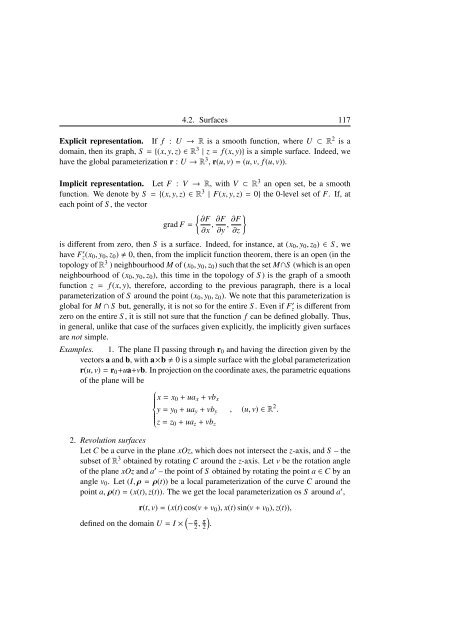Blaga P. Lectures on the differential geometry of - tiera.ru
Blaga P. Lectures on the differential geometry of - tiera.ru
Blaga P. Lectures on the differential geometry of - tiera.ru
Create successful ePaper yourself
Turn your PDF publications into a flip-book with our unique Google optimized e-Paper software.
4.2. Surfaces 117<br />
Explicit representati<strong>on</strong>. If f : U → R is a smooth functi<strong>on</strong>, where U ⊂ R 2 is a<br />
domain, <strong>the</strong>n its graph, S = {(x, y, z) ∈ R 3 | z = f (x, y)} is a simple surface. Indeed, we<br />
have <strong>the</strong> global parameterizati<strong>on</strong> r : U → R 3 , r(u, v) = (u, v, f (u, v)).<br />
Implicit representati<strong>on</strong>. Let F : V → R, with V ⊂ R 3 an open set, be a smooth<br />
functi<strong>on</strong>. We denote by S = {(x, y, z) ∈ R 3 | F(x, y, z) = 0} <strong>the</strong> 0-level set <strong>of</strong> F. If, at<br />
each point <strong>of</strong> S , <strong>the</strong> vector<br />
grad F =<br />
� ∂F<br />
∂x<br />
�<br />
∂F ∂F<br />
, ,<br />
∂y ∂z<br />
is different from zero, <strong>the</strong>n S is a surface. Indeed, for instance, at (x0, y0, z0) ∈ S , we<br />
have F ′ z(x0, y0, z0) � 0, <strong>the</strong>n, from <strong>the</strong> implicit functi<strong>on</strong> <strong>the</strong>orem, <strong>the</strong>re is an open (in <strong>the</strong><br />
topology <strong>of</strong> R 3 ) neighbourhood M <strong>of</strong> (x0, y0, z0) such that <strong>the</strong> set M∩S (which is an open<br />
neighbourhood <strong>of</strong> (x0, y0, z0), this time in <strong>the</strong> topology <strong>of</strong> S ) is <strong>the</strong> graph <strong>of</strong> a smooth<br />
functi<strong>on</strong> z = f (x, y), <strong>the</strong>refore, according to <strong>the</strong> previous paragraph, <strong>the</strong>re is a local<br />
parameterizati<strong>on</strong> <strong>of</strong> S around <strong>the</strong> point (x0, y0, z0). We note that this parameterizati<strong>on</strong> is<br />
global for M ∩ S but, generally, it is not so for <strong>the</strong> entire S . Even if F ′ z is different from<br />
zero <strong>on</strong> <strong>the</strong> entire S , it is still not sure that <strong>the</strong> functi<strong>on</strong> f can be defined globally. Thus,<br />
in general, unlike that case <strong>of</strong> <strong>the</strong> surfaces given explicitly, <strong>the</strong> implicitly given surfaces<br />
are not simple.<br />
Examples. 1. The plane Π passing through r0 and having <strong>the</strong> directi<strong>on</strong> given by <strong>the</strong><br />
vectors a and b, with a×b � 0 is a simple surface with <strong>the</strong> global parameterizati<strong>on</strong><br />
r(u, v) = r0+ua+vb. In projecti<strong>on</strong> <strong>on</strong> <strong>the</strong> coordinate axes, <strong>the</strong> parametric equati<strong>on</strong>s<br />
<strong>of</strong> <strong>the</strong> plane will be<br />
⎧<br />
x = x0 + uax + vbx<br />
⎪⎨<br />
y = y0 + uay + vby<br />
⎪⎩ z = z0 + uaz + vbz<br />
, (u, v) ∈ R 2 .<br />
2. Revoluti<strong>on</strong> surfaces<br />
Let C be a curve in <strong>the</strong> plane xOz, which does not intersect <strong>the</strong> z-axis, and S – <strong>the</strong><br />
subset <strong>of</strong> R 3 obtained by rotating C around <strong>the</strong> z-axis. Let v be <strong>the</strong> rotati<strong>on</strong> angle<br />
<strong>of</strong> <strong>the</strong> plane xOz and a ′ – <strong>the</strong> point <strong>of</strong> S obtained by rotating <strong>the</strong> point a ∈ C by an<br />
angle v0. Let (I, ρ = ρ(t)) be a local parameterizati<strong>on</strong> <strong>of</strong> <strong>the</strong> curve C around <strong>the</strong><br />
point a, ρ(t) = (x(t), z(t)). The we get <strong>the</strong> local parameterizati<strong>on</strong> os S around a ′ ,<br />
r(t, v) = (x(t) cos(v + v0), x(t) sin(v + v0), z(t)),<br />
�<br />
.<br />
defined <strong>on</strong> <strong>the</strong> domain U = I × � − π π<br />
2 , 2












